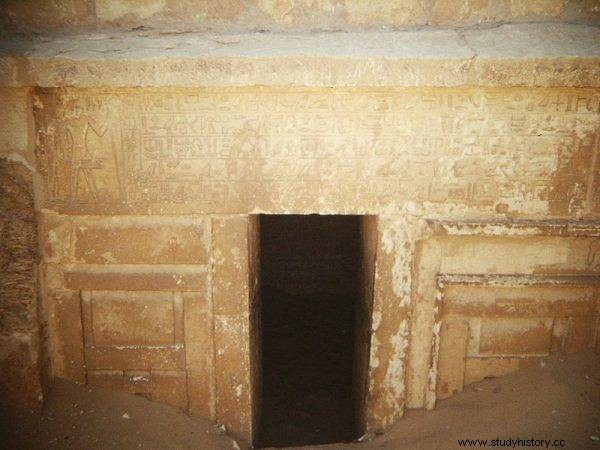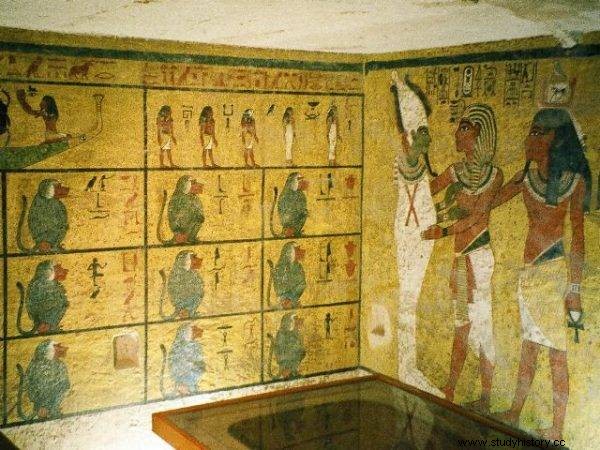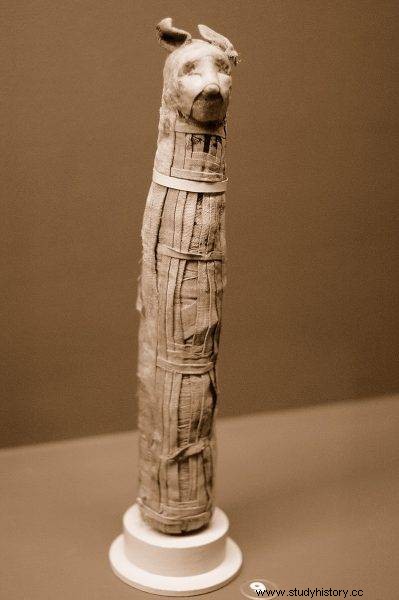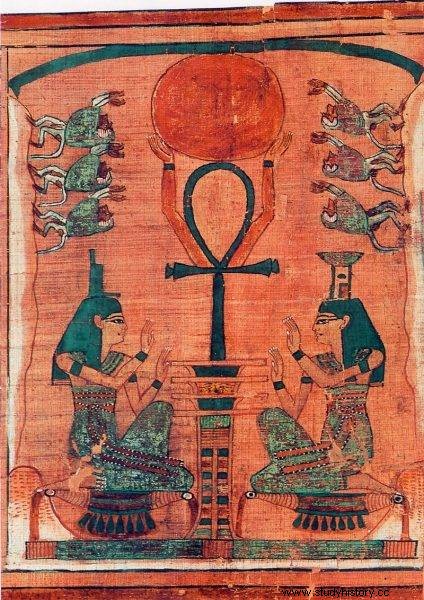The art, architecture and funeral writings of the Pharaohs state still amaze and fascinate researchers. This culture was "permeated" with the cult of death and life on the other side. For him, it was worth building tombs the size of huge buildings, which, in addition, were fully equipped - like a living man's dwelling.
Although it might seem that scientists know everything about the monumental tombs of the pharaohs and Egyptian dignitaries, subsequent archaeological research continues to reveal new finds. The authors of the documentary series "Tombs of Egypt", who participated in a three-month research expedition to the intact tomb complex in Saqqara, hidden deep in the sands of the desert, at the foot of the Pharaoh Teti pyramid, got a unique chance to "see" the newly discovered tomb.
Posthumous apartment
The "basin" of the tombs of Egyptian rulers is of course the so-called Valley of the Kings, next to Luxor. Archaeological work was particularly intense here in the interwar period of the 20th century. It was then that the two archaeologists Carter and Carnarvon found a grave, which immediately became a sensation and is still the most "media" find among ancient Egyptian tombs. It is, of course, the tomb of the 17-year-old pharaoh, Tutankhamun. In 1922, researchers found stairs leading deep into the ground - to a partially closed - door. This was the beginning of a gradual discovery of the mighty, treasure-filled tomb.

The authors of the documentary series "Tombs of Egypt", who participated in a three-month research expedition to the intact tomb complex in Saqqara, were given a unique chance to "see" the newly discovered tomb.
The pharaoh's tomb, carved in solid rock, consisted of stairs, a 7-meter corridor with entrances to other rooms on the sides:a vestibule (8 × 3.6 m), a side chamber (approx. 4 × 2.9 m), a chamber mortuary (6.4 × 4.05 m) and a treasury (approx. 4 × 3.5 m). The chambers were simultaneously connected with each other by additional passages walled up in the rock.
Pharaoh took with him to that world, among others three beds made of gold, a golden throne, decorated chests, many statues, including one golden . Four gilded chariots, household appliances, musical instruments and kilograms of food were also placed in the grave.
In the burial chamber itself, there are four chests made of gold sheet and a quartzite sarcophagus (2.75 × 1.5 × 1.5 m). Inside the sarcophagus there are three coffins made of gold metal in the shape of a pharaoh. On the face of the pharaoh there was a golden mask, weighing more than 10 kg, decorated with precious stones - incl. obsidian and lapis lazuli.
This type of equipment was nothing special. The full assortment of the rulers needed during their lifetime is brought to the tombs of the rulers, such as furniture, tableware, cosmetics, toiletries, clothes, mirrors, games, amulets and written advice for the soul - about what she should do to get to Osiris and ultimately to paradise.
It was a common practice to leave letters in their graves to the deceased, in which living family members wrote about current events in their lives, told anecdotes, raised quite banal matters - such as the need to stockpile, etc. From their point of view, death was not the end of a clear caesura, and a continuum in which the dead simply passed over to another dimension of existence. They still played an important role for this world, so they were often asked to intercede with the gods and "settle" specific matters, for example, to obtain divine help in building a house, or other tangible matters.
Read also:Secrets of the Mayan tombs The journey was incredible
In Tutankhamun's tomb, researchers found something else that indicates that the pharaoh did not go to that world alone. Among the treasures, two more modest, small sarcophagi were also discovered. There were mummies inside… children. Modern research has shown that these were the remains of girls who were born dead . Were the children of Pharaoh buried with the ruler? DNA research suggests that it may indeed have been the corpse of Tutankhamun's tragically prematurely deceased daughters. The homework of the Pharaoh's children was a tribute to them and an expression of the parental bond, presumably assuming that the souls of the father and daughters would go together to the Egyptian paradise, i.e. the Fields of Jaru.

Wall paintings in the burial chamber of Tutankhamun's tomb
It happened that the ruler was accompanied on the last journey by living people - servants or concubines. Most often, however, so that the soul would not have to take care of itself after death, special figurines - shashbti - were put into the grave, which symbolized the service whose task was to serve, look after the pharaoh and perform typical works in that world.
The fields of Jaru, and thus the Egyptian paradise, were a place where you also had to work, even if you could always harvest a lot . The inhabitants of this kind of improved version of Egypt never suffered from hunger, they did not complain about crop failure, but the crops had to be harvested, even if it were to be done by the soul, not by the physical man.
A culture of death
Many ancient cultures showed a strong interest in death and dying. The issue of preparing in mortality for the correct transition to that world was an extremely important aspect of the existence of the people of the first civilizations, but even against their background, ancient Egypt was unique.
The life of the Egyptians was completely subordinated to the impending death. For this purpose, in order to preserve the "functional" body, a kind of container for the soul, the corpse was mummified. The Egyptians were obsessed with it. They were masters of the mummification of bodies, which during the entire, extremely extensive, 70-day procedure, were treated as living creatures - not only humans, but also animals. Animal mummifications took place on a gigantic scale. Cats, dogs, wild animals were mummified - crocodiles, ibises, falcons, etc. - the entire zoo . All this so that the quadrupeds accompany people in that world. Suffice it to say that several million animal mummies have been discovered in Saqqara alone.
When it comes to the human ones, when the body had a defect, e.g. it did not have a leg or arm, professional embalmers in the masks of the god Anubis, made additional limbs (using e.g. animal bones), thanks to which the deceased could enjoy the full efficiency on the other side of life .

Egyptian mummy of a cat
The most important signpost for the Egyptians, a sacred text, a map and a set of laws and valuable advice for the soul who, after the funeral opening ceremony of the mouth, awoke with all earthly senses fit, but already as ah - a spiritual being, was the so-called Book of the Dead.
It contained detailed descriptions of the path that awaits the deceased in the Fields of Jar, if, of course, Osiris' judgment passes. In addition, there were spells, instructions to say them, illustrations, and even a detailed topography of the underworld. The book was so popular that it was copied on a mass scale, leaving room for the owner's name to be entered. In this way, everyone could have their own guide and a complete compendium of knowledge about navigating in the eternal world.

If you are fascinated by ancient archeology and you like programs related to Egypt, this series of interesting documentaries on Polsat Viasat History is for you! "Ancient Egypt" can be watched from 7 March on weekdays at 20:00. You can't miss this!
After physical death, the Egyptian's soul went to the Hall of the Two Truths, where it was judged by the tribunal of Osiris, who weighed the good and bad deeds performed during his lifetime. One of the scales was filled with the heart of the deceased, and the other with a feather, the symbol of the goddess of truth - Maat. Osiris himself, as well as Nephtyda, Isis and 42 assessors heard the confession of the deceased. There was no appeal against God's judgment. If the heart turned out to be light, the deceased would go to paradise. If, however, the weight of sins was outweighed by the feather of truth, the terrible monster Ammit - a hybrid with the body of a lion, hippopotamus and the head of a crocodile - kidnapped and ate the heart of the unfortunate, thereby killing him spiritually . It was the only death the Egyptians knew. This physical one was only a transition to the eternal world. Only here it was possible to be completely annihilated, for failing the exam in life, to really die - the death of the soul.
Bibliography:
- Ikram S. " Death and Burial in Ancient Egypt" , PIW, Warsaw 2004, pp. 110-111,
- Niwiński A. "Myths and symbols of Ancient Egypt" , PRO-EGYPT, Warsaw 2001
- Hamilton R. "Ancient Egypt", Parragon, 2008
